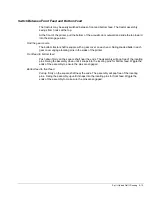
Set It Up and Get It Running 2-21
A Note About Print Head Gap Adjustment
Print head gap is the distance from the print head nozzle to the striker bar. If this gap is too
tight, characters will smudge. If the gap is too large, characters will be light and ragged, the
printer will be noisy, and print head wear will accelerate.
As shipped, the dual path printer is configured to automatically adjust the print head gap
whenever paper is loaded. Single path machines have semi-automatic (or manual) gap
adjustment selected as the default. The printer senses the thickness of a form when it is
loaded and adjusts the print gap accordingly. The automatic gap adjustment process will leave
a small (one print wire diameter) black mark near the top of the first form as the form loads.
The automatic print head adjustment can be fine tuned for best print quality. Semiautomatic
head gap adjustment and fixed head gap may also be selected. For more information on these
selections see Chapter 7.
Adjust Top-of-Form
When loading the very first form, the printer feeds paper so that the top of the first printable
line of characters is slightly below the top of the paper. Ideally, the application software that
composes the page should advance paper to the first print line upon printing.
To adjust vertical paper position, make sure the printer is not in the menu mode. Use the UP
ARROW and DOWN ARROW keys to advance or retract the paper, much like a paper
advance knob on some printers.
8
Moves paper up by 1/72 inch per click. Experiment with it and see how it works.
9
Moves paper down by 1/72 inch per click. Do not move paper down enough to print on the
striker bar.
Instead of using the UP ARROW key to adjust the same amount of offset each time a
particular form is loaded, that offset can be stored in a parameter called
top print reference
and saved to a format. If a top print reference is saved, paper will advance to the right place
each time that paper path is loaded. See “Set a Top Print Reference” in Chapter 8.
NOTE: Using the UP or DOWN ARROW keys cause an “unregistered” paper move; the
printer electronics does not recognize or store the fact that paper has moved. Using
the linefeed (LF) key to adjust vertical position causes a “registered” move.






























